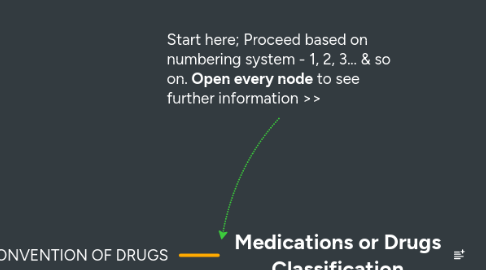
1. Sujoy Bose. PT, DPT, MHS, BSPT. Diplomate, ABPTS (Cardiovascular & Pulmonary) Associate Professor | Marshall University - Own Work. Copyright: Creative Commons https://creativecommons.org/licenses/by-sa/3.0/ - Last update May 2, 2023.
2. 3. Schedule of Controlled Substances
3. 1. CONVENTION OF DRUGS
3.1. ALLOPATHIC Drugs - WESTERN MEDICINE
3.1.1. Non-Prescription Drugs (OTC)
3.1.2. Prescription Drugs
3.2. ALTERNATIVE MEDICINE
3.2.1. Herbal Drugs
3.2.2. Homeopathic Drugs
3.2.3. Ayurvedic Drugs
4. Start here; Proceed based on numbering system - 1, 2, 3... & so on. **Open every node** to see further information >>
5. 2. CLASSIFICATION OF ALLOPATHIC (WESTERN) MEDICINE/DRUGS
5.1. Pharmacologic Classification
5.1.1. Similar Characteristics
5.1.1.1. Same Indications
5.1.1.2. Same Mechanism of Action, e.g. >>
5.1.1.2.1. Angiotensin-Converting Enzyme Inhibitors (ACE-I) tell you exactly how they work
5.1.1.3. Same Contraindications, & Precautions
5.1.1.4. Same Interactions
5.1.1.5. Same Adverse Reactions & Side-effects
5.1.2. Similar Chemical Make-up
5.1.3. Knowing the Pharmacologic Class is necessary when determining treatment action >>
5.1.3.1. A Doctor might say >>
5.1.3.1.1. "An ACE-inhibitor is more desirable than a beta-blocker"
5.1.3.1.2. "Your heart won't race as much because the beta-blocker prevents autonomic receptors in the heart from being stimulated"
5.1.4. Clues to identifying if Pharmacologic Class is being used to describe the drugs
5.1.4.1. Generic Names of Drugs in same Pharmacologic Class OFTEN (not always) have the same SUFFIX. e.g. >>
5.1.4.1.1. Beta-blockers (therapeutic class Anti-hypertensives) - end in "-olol". e.g.: Propranolol, Atenolol
5.1.4.1.2. ACE-Inhibitors (therapeutic class Anti-hypertensives) - end in "-pril". e.g. Enalapril, Benazepril, Captopril, Ramipril, etc.
5.1.4.1.3. Benzodiazepines (therapeutic class Sedative-Hypnotics), - end in "-epams" Or, "-zolams" - e.g. Diazepam, Midazolam, etc.
5.1.4.1.4. Monoclonal Antibodies end in "-mab" e.g. Rituximab
5.1.5. Drugs of same pharmacologic class differ in the following ways
5.1.5.1. Dosage
5.1.5.2. Time Action Profile
5.1.5.3. Availability
5.1.6. Examples:
5.1.6.1. Penicillins
5.1.6.2. Beta-blockers
5.1.6.3. ACE-Inhibitors
5.1.6.4. Others
5.2. Therapeutic Classification
5.2.1. Broad categories used for Similar Therapeutic Effect
5.2.2. May NOT have similar chemical makeup
5.2.3. Have different Mechanisms-of-Action even though they may target the same end-effect
5.2.4. Therapeutic Classes include many pharmacologic classes
5.2.4.1. e.g. The therapeutic class Anti-hypertensives, has at least 13 Pharmacologic classes
5.2.5. Therapeutic Class is useful when speaking of drugs in a "general way" - see examples
5.2.5.1. "Antihypetensives save lives"
5.2.5.2. "You will need anti-anginal medication"
5.2.6. Examples:
5.2.6.1. Anti-hypertensives
5.2.6.2. Anti-anginals
5.2.6.3. Sedatives, Hypnotics, Anxiolytics
5.2.6.4. Antibiotics
5.2.6.5. Anti-hemorrhoid drugs
5.2.6.6. Topical Antibiotics
5.2.6.7. Cough Suppressants
5.2.6.8. Analgesics
5.2.6.8.1. Non-Steroidal Anti-inflammatory Drugs
5.2.6.8.2. Steroidal Anti-inflammatory Drugs
5.2.6.8.3. Opioids
5.2.6.9. Antiseptics
5.2.6.10. Others
5.3. Based on Primary Target System
5.3.1. CNS Drugs
5.3.1.1. CNS Stimulants
5.3.1.1.1. Used in disorders where CNS is naturally depressed
5.3.1.2. CNS Depressants
5.3.1.2.1. CNS hyperactive disorders
5.3.1.2.2. Pain Relief
5.3.2. Autonomic Drugs
5.3.2.1. Cardiac Drugs
5.3.2.1.1. Agonists Drugs
5.3.2.1.2. Antagonist Drugs
5.3.2.2. Pulmonary Drugs
5.3.2.2.1. Agonist Drugs
5.3.2.2.2. Antagonist Drugs
5.3.3. Musculoskeletal Drugs
5.3.3.1. Modifies Natural Metabolic Pathways (NSAIDS, & CSIs) - see mind map at this link
5.3.3.1.1. Pain Relief that assists with Exercise & Mobility
5.3.3.2. CNS Stimulants (Opioids) - see mind map at this link
5.3.3.2.1. Muscle Relaxation
5.3.3.2.2. Pain Relief by Alteration of Consciousness
5.3.3.3. Blocks Nerve Pathways (See Anesthetic Agents - especially local nerve blocks) - see mind map at this link
5.3.3.3.1. Skeletal Muscle Relaxants
5.3.3.3.2. Pain Medications
5.3.3.4. Receptor Antagonists (Blocks Motor End-plates in Muscles - Neuromuscular Blocking Agents or NMBAs - see mind map at this link
5.3.3.4.1. Muscle Relaxation
5.3.4. Gastrointestinal Drugs
5.3.4.1. Anti-Acidity
5.3.4.1.1. Antacids
5.3.4.1.2. H2-Receptor Antagonists
5.3.4.1.3. PPIs
5.3.4.2. Anti-Diarrheals
5.3.4.3. Laxatives
5.3.5. Endocrine Drugs
5.3.5.1. Drugs for Diabetes
5.3.5.1.1. Many Pharmacologic Classes
5.3.5.2. Others
5.3.5.2.1. Many Drug Categories depending on endocrine organ requiring treatment
5.3.6. Antibiotics
5.3.6.1. Many Pharmacologic Groups
5.3.7. Chemotherapy Drugs
5.3.7.1. Many Pharmacologic Groups
